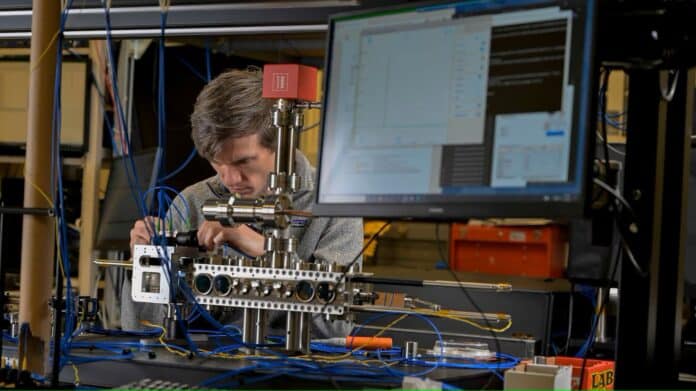The U.S. Naval Research Laboratory (NRL) researchers have developed a new navigation tool called the Continuous 3D-Cooled Atom Beam Interferometer. This technology is based on a cold and continuous beam of atoms and is aimed at exploring atom-interferometry-based inertial measurement systems. The goal is to reduce drift in Naval navigation systems.
Inertial navigation is a self-contained navigation technique that uses measurements provided by accelerometers and gyroscopes to track the position and orientation of an object relative to a known starting point, orientation, and velocity. Quantum inertial navigation is a new field of research and development that can significantly increase inertial measurement accuracy.
“Our interferometer operates in a different regime than most other modern implementations of an atom interferometer,” said Jonathan Kwolek, Ph.D., a research physicist from the NRL Quantum Optics Section within the Optical Sciences Division. “By operating with cold, continuous atoms, we have opened the door to a number of advantages as well as novel measurement techniques. Ultimately, we would like to use this technology to improve inertial navigation systems, thus reducing our reliance on GPS.”
By leveraging the unique properties of the atom source, the Continuous 3D-Cooled Atom Beam Interferometer is able to achieve high measurement contrast, low noise, and improved handling of variations in the sensor’s environment. With such capabilities, this technology has the potential to help the Navy operate in GPS-denied environments and overcome limitations to the accuracy of GPS.
The technology can be particularly useful in situations where errors in location estimation accumulate over time, leading to loss of accurate position information. Current commercially available inertial navigation systems can navigate with an error accumulation of roughly one nautical mile over 360 hours. NRL aims to develop new technologies that could help extend mission duration by minimizing navigational drift.
“The field of inertial navigation aims to provide navigation information anywhere GPS is unavailable,” said NRL Associate Director of Research for Systems Dr. Gerald Borsuk. “The advent of atom interferometry allows for a novel approach in inertial sensing, which has the potential to address some of the deficiencies in current state-of-the-art technologies.”
GPS has become an indispensable part of our civilian and military world, with its ability to provide high-accuracy position and timing information worldwide. However, there are certain environments where it fails to function, such as underwater or in space. Additionally, there is a growing concern about the threat to GPS availability through jamming, spoofing, or anti-satellite warfare.
“In an ideal world, we hedge against loss of conventional navigation by making the best inertial navigators we can,” Kwolek said. “This is to ensure that a loss of GPS doesn’t allow our ships to become lost in the middle of enemy territory.”
While initially designed for military use, GPS has been adapted for civilian navigation purposes. From commercial aviation to handheld devices, GPS has become an indispensable tool for navigation and timing.
With a constellation of 32 satellites orbiting the Earth, GPS provides precise data to military and civilian users worldwide. However, despite the significant progress made in GPS technology over the years, the Navy still employs optimized inertial navigation systems to avoid complete reliance on GPS, thus mitigating risks.
“In the modern era, NRL is one of several research organizations addressing naval inertial navigation challenges,” said Adam Black, Ph.D., NRL Quantum Optics Section Head. “The lab is taking advantage of advanced atomic and optical techniques to invent new architectures for inertial measurement that promise accurate navigation of dynamic Navy platforms.”
